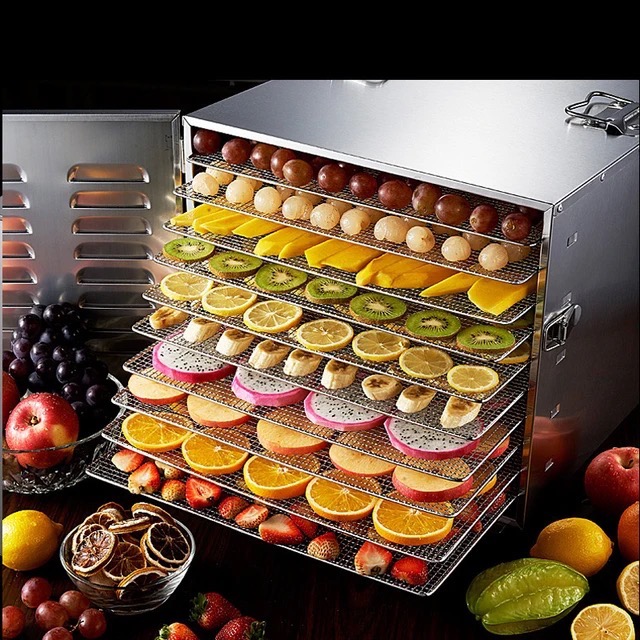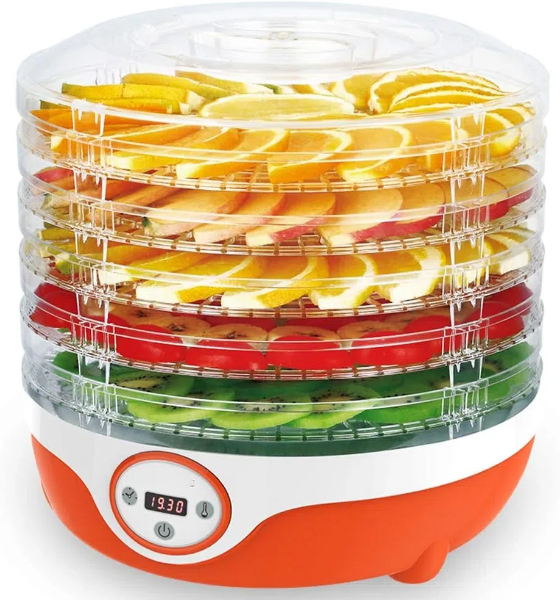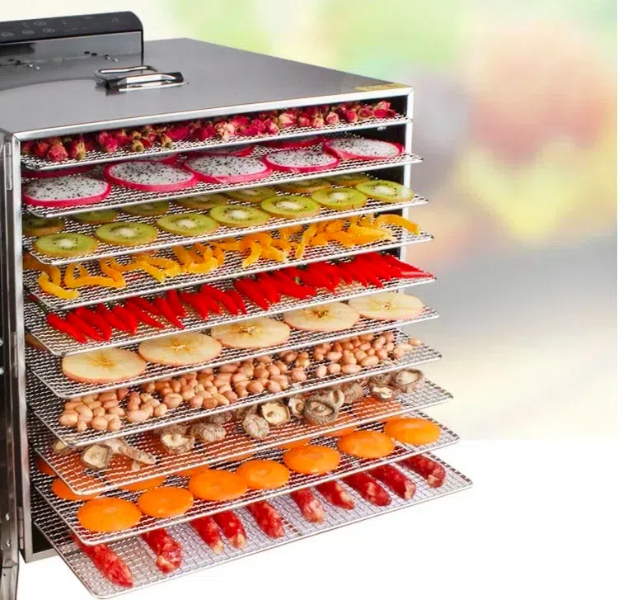
Content Menu
● Introduction to Fruit Dehydration
● Types of Fruit Dryer Machines
>> Home Food Dehydrators
>> Commercial Fruit Dryers
>> Multi-tier Food Dehydrators
● Key Features to Consider When Choosing a Fruit Dryer Machine
>> Capacity and Size
>> Temperature Control
>> Airflow and Fan System
>> Energy Efficiency
>> Material and Construction
● Fruit Drying Techniques and Best Practices
>> Preparation
>> Temperature and Time
>> Rotating Trays
>> Testing for Doneness
● Benefits of Using a Fruit Dryer Machine
>> Preservation of Nutrients
>> Extended Shelf Life
>> Space-Saving Storage
>> Versatility in Culinary Applications
● Maintenance and Cleaning of Fruit Dryer Machines
>> Regular Cleaning
>> Inspecting and Replacing Parts
>> Proper Storage
● Innovative Uses for Fruit Dryer Machines
>> Homemade Pet Treats
>> Dried Herbs and Spices
>> Crafting Materials
● Conclusion
● Frequently Asked Questions
>> 1. What is the best temperature for drying fruits?
>> 2. How long does it take to dry fruits in a dehydrator?
>> 3. Can I use a fruit dryer machine for vegetables and herbs?
>> 4. How do I store dried fruits properly?
>> 5. Are there any fruits that shouldn't be dried in a dehydrator?
Introduction to Fruit Dehydration
Fruit dehydration is an ancient preservation technique that has evolved with modern technology. Today, the best fruit dryer machines offer an efficient and convenient way to preserve fruits, vegetables, and other foods while retaining their nutritional value and flavor. Whether you're a home enthusiast or a commercial producer, understanding the ins and outs of fruit dryers can help you make the most of your harvest and reduce food waste.
Types of Fruit Dryer Machines
Home Food Dehydrators
Home food dehydrators are perfect for individuals and families who want to preserve small to medium quantities of fruits and vegetables. These compact machines typically feature multiple trays and adjustable temperature settings, allowing users to dry various types of produce efficiently.
Commercial Fruit Dryers
For larger-scale operations, commercial fruit dryers offer increased capacity and advanced features. These machines are designed to handle high volumes of produce and often come with more precise temperature and humidity controls.
Multi-tier Food Dehydrators
Multi-tier food dehydrators are versatile machines that can accommodate various quantities of produce. With expandable tray systems, these dehydrators allow users to adjust the drying capacity based on their needs.

Key Features to Consider When Choosing a Fruit Dryer Machine
Capacity and Size
The capacity of your fruit dryer machine should match your intended use. Home users may find smaller units sufficient, while commercial operations will require larger, more robust machines. Consider the available space in your kitchen or facility when selecting a fruit dryer.
Temperature Control
Precise temperature control is crucial for achieving optimal results when drying different types of fruits and vegetables. Look for machines that offer a wide temperature range and accurate controls to ensure consistent drying.
Airflow and Fan System
Efficient airflow is essential for even drying and preventing hot spots. High-quality fruit dryer machines feature powerful fans and well-designed airflow systems to distribute heat evenly across all trays.
Energy Efficiency
Energy-efficient fruit dryers can help reduce operating costs, especially for frequent users or commercial operations. Look for models with energy-saving features and good insulation to maximize efficiency.
Material and Construction
Stainless steel fruit dryers are popular due to their durability, ease of cleaning, and resistance to corrosion. Consider the quality of construction and materials used in the machine to ensure longevity and food safety.
Fruit Drying Techniques and Best Practices
Preparation
Proper preparation is key to achieving high-quality dried fruits. Wash and slice fruits evenly to ensure consistent drying. Some fruits may benefit from pre-treatment, such as dipping in lemon juice to prevent browning.
Temperature and Time
Different fruits require different drying temperatures and times. Generally, lower temperatures (around 135°F/57°C) are best for preserving nutrients and flavor. Drying times can range from 6 to 36 hours, depending on the fruit and desired texture.
Rotating Trays
For even drying, rotate trays periodically during the dehydration process. This helps ensure all pieces dry at the same rate and prevents over-drying or under-drying.
Testing for Doneness
Properly dried fruits should be pliable but not sticky. To test for doneness, allow a piece to cool before checking its texture. If it's still too moist, continue drying in short intervals.

Benefits of Using a Fruit Dryer Machine
Preservation of Nutrients
Fruit dryer machines help preserve the nutritional value of fruits and vegetables by removing water content while retaining vitamins, minerals, and fiber. This makes dried fruits a healthy and convenient snack option.
Extended Shelf Life
Dehydrated fruits can last for months or even years when stored properly, reducing food waste and allowing you to enjoy your favorite fruits year-round.
Space-Saving Storage
Dried fruits take up significantly less space than fresh produce, making them ideal for compact storage and easy transportation.
Versatility in Culinary Applications
Dried fruits can be used in a variety of culinary applications, from baking and cooking to creating homemade trail mixes and granolas.
Maintenance and Cleaning of Fruit Dryer Machines
Regular Cleaning
Clean your fruit dryer machine after each use to prevent the buildup of food residue and maintain hygiene. Most trays and components are dishwasher-safe, but always consult the manufacturer's instructions.
Inspecting and Replacing Parts
Regularly inspect your fruit dryer for signs of wear and tear. Replace any damaged parts promptly to ensure optimal performance and food safety.
Proper Storage
When not in use, store your fruit dryer in a clean, dry place to protect it from dust and moisture. This will help prolong the life of your machine and ensure it's ready for use when needed.
Innovative Uses for Fruit Dryer Machines
Homemade Pet Treats
Use your fruit dryer machine to create healthy, preservative-free treats for your pets. Dehydrated sweet potato slices or apple chips make excellent dog treats.
Dried Herbs and Spices
Expand beyond fruits and vegetables by using your dryer to preserve fresh herbs and create your own dried spice blends.
Crafting Materials
Dried flowers and leaves can be used in various craft projects, from potpourri to decorative arrangements. Your fruit dryer can help preserve these materials for long-term use.
Conclusion
Investing in the best fruit dryer machine can open up a world of possibilities for preserving and enjoying fruits, vegetables, and other foods. By considering factors such as capacity, temperature control, and energy efficiency, you can find the perfect fruit dehydration machine for your needs. Whether you're a home enthusiast or a commercial producer, mastering fruit drying techniques will allow you to create delicious, nutritious, and long-lasting dried fruits that can be enjoyed year-round.

Frequently Asked Questions
1. What is the best temperature for drying fruits?
Answer: The optimal temperature for drying most fruits is between 135°F and 145°F (57°C to 63°C). This range helps preserve nutrients and flavor while ensuring proper dehydration. However, some fruits may require slightly different temperatures, so it's essential to consult specific guidelines for each type of fruit.
2. How long does it take to dry fruits in a dehydrator?
Answer: The drying time for fruits can vary depending on the type of fruit, its water content, and the thickness of the slices. On average, it can take anywhere from 6 to 36 hours to fully dehydrate fruits. Berries and thinly sliced fruits may dry in as little as 6-8 hours, while denser fruits like apples or pears can take 12-24 hours or more.
3. Can I use a fruit dryer machine for vegetables and herbs?
Answer: Yes, most fruit dryer machines are versatile and can be used to dehydrate a wide range of foods, including vegetables and herbs. Many models come with specific settings or guidelines for drying different types of produce, allowing you to preserve a variety of foods using the same machine.
4. How do I store dried fruits properly?
Answer: To maintain the quality of dried fruits, store them in airtight containers in a cool, dry, and dark place. Glass jars with tight-fitting lids or vacuum-sealed bags are excellent options. Properly stored dried fruits can last for 6-12 months. For longer storage, you can keep them in the refrigerator or freezer, which can extend their shelf life up to 18 months or more.
5. Are there any fruits that shouldn't be dried in a dehydrator?
Answer: While most fruits can be successfully dried, some are not ideal for dehydration due to their high fat or water content. Avocados, for example, are not suitable for drying due to their high fat content. Very juicy fruits like watermelon can be challenging to dry effectively. Additionally, fruits with large pits or seeds should be pitted before drying to ensure even dehydration and prevent spoilage.












